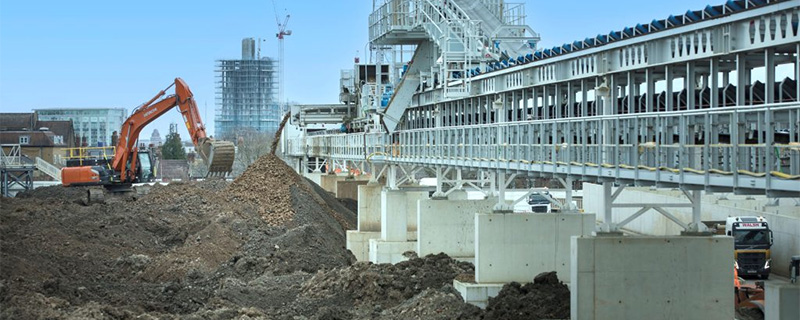Repurposed London Clay as low-carbon cement alternative
Funding for further trials of repurposed London Clay as low-carbon cement alternative
High Speed 2 London tunnels team Skanska Costain Strabag Joint Venture bags funding from Innovate UK’s £3.2M pot for trialling repurposed London Clay as an alternative to carbon-intensive Portland cement.
The Skanska Costain Strabag Joint Venture (SCS JV) project is one of six recipients of £3.2M in Innovate UK funds, which could help the UK’s concrete industry accelerate its decarbonisation efforts.
SCS JV will use its part of the funding to carry out further research and testing into using calcined London Clay – excavated from tunnel activities – as a replacement for Portland cement in concrete for High Seep 2 (HS2) permanent works.
Portland cement production is highly energy-intensive and emits large amounts of CO2. Replacing it with calcined London Clay could lead to reductions in greenhouse gas emissions.
The JV is working on the project together with client HS2 Ltd, technical lead Arup, concrete supplier Tarmac, the University of Leeds and Sika UK, along with Expedition Engineering and the Mineral Product Association (MPA).
Skanska materials engineering manager Apostolos Tsoumelekas, who has been heavily involved in the project, said: “The clay that is excavated from the HS2 tunnels is essentially a waste product. We have developed a process which calcines the clay and grinds it to a powder transforming it into a useful resource which can then be added to concrete replacing Portland cement. The results have been impressive and hopefully if it’s scaled up it could really help speed up the adoption of low-carbon concrete for commercial use.”
Background
The funding builds on the Re-purposed Excavated Arising Loop (REAL) initiative, a feasibility study established to address the challenge of excess tunnel and excavation materials from the HS2 London tunnels.
he majority of this waste material consists of London Clay. The REAL initiative explored ways to repurpose this clay, initially focusing on two potential applications: as expanded clay aggregate (lightweight aggregate – LWA) and as a supplementary cementitious material (SCM) to replace Portland cement in concrete.
According to Tsoumelekas, the project underwent multiple stages:
- Stage 1a: Testing London Clay for its suitability as SCM and LWA
- Stage 1b: Designing and optimising concrete mixes incorporating London Clay-derived SCM and LWA
- Stage 2: Setting up a pilot clay processing facility and using its outputs in construction works.
The team discovered that while London Clay could be used for both applications, its use as SCM provided the most substantial benefits, Tsoumelekas told GE.
The results of the REAL study showed a reduction in carbon figures and suggested potential savings of tens of millions of pounds on a project the size of HS2. However, further research was required.
The preliminary trials have thus paved the way for this latest funding to help scale up production.
Calcined London Clay
When asked about the suitability of calcined London Clay as a low-carbon alternative to Portland cement, Tsoumelekas said: “Simplistically, the mineralogy of the London Clay will determine its suitability. A key parameter indicating the reactivity of clays is the kaolinite content, which can subsequently be used to justify a clay’s suitability as a SCM.
“We have found that despite London Clay’s relatively low kaolinite content, it is possible to be used as a beneficial supplementary cementitious material.”
Despite its promise, using London Clay as an SCM comes with challenges. One of the key hurdles is the limited availability of calcination facilities in the UK.
“Based on the data from the REAL initiative, we have proven that low/moderate reactivity clays can be used as SCM in concrete to produce structural concrete mix designs,” Tsoumelekas added.
“The funding will help with scaling up of the calcination of the excavated London Clay and will assist with the assessment of long term durability aspects.”
Preliminary data has shown that calcined clays as SCM can be used in medium-strength structural concrete mixes, with the potential to achieve even higher compressive strengths through optimised concrete mixes.
“Calcined clays as SCM are permitted in the relevant standards, up to a certain replacement percentage,” Tsoumelekas told GE.
“The funding will also assist with the development of admixtures that will assist with the performance of the designed concrete mixes with higher calcined clay contents. Its long-term durability will also be tested and assessed.”
In summary, Tsoumelekas said, the funding will be used to help with the characterisation of the raw and calcined form of the London Clay, the development of appropriate concrete mixes and relevant admixtures, as well as long and short term durability aspects.
Source: Ground Engineering









Leave a Reply
Want to join the discussion?Feel free to contribute!